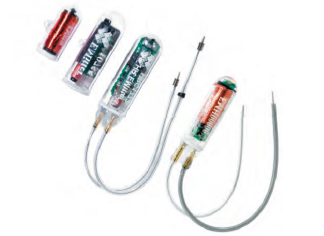|
||||||||||||||||||||||||||||||
| [发表评论] [本类其他产品] [本类其他供应商] [收藏] | ||||||||||||||||||||||||||||||
| 销售商: 上海玉研科学仪器有限公司 | 查看该公司所有产品 >> |
可对大鼠、小鼠的体温、心率、活动量,进行无线式、长时间的测量和记录
植入式生理信号无线遥测系统用于长时间测量清醒无束缚的大鼠、小鼠、兔子、比格犬、猴子、鱼等多种动物的心率、体温和活动量等生理参数。使用此系统可以保证动物在笼内自由活动,不需要麻醉或束缚,这样测量到的生理信号更能反映自然状态下的动物生理状况。可用于生物节律研究和相关的生命体征监测。
植入式生理信号无线遥测系统可无线遥测和记录实验动物的:心率、体温、活动量.
植入式生理信号无线遥测系统由植入体(E-Mitter)、接收数据转换器(Receiver)、电缆和记录分析计算机(VitalView)构成。1厘米大小的植入体E-Mitter集成了传感器、放大器和无线信号发射器,根据测量信号不同有多种规格。植入式E-Mitter转发器不需电池,由接收数据转换器(Receiver)输出电力。实验人员将植入体埋入动物皮下,生理信号被植入体采集到并转换成相应的电信号后用无线电发射出来,由饲养笼下方的接收器接收到并传递给数据转换器,完成数据转换后送入中央处理器进行数据处理。系统最多可同时连接32个接收器,完成大规模的试验。
植入体(E-Mitter)是植入在动物体内的微型设备,它集成了传感器,放大器,数字转换,无线发射的功能并解决了生物体的抗排异反应。植入体有用于测量生物心率,体温和活动量等多种参数的规格。

植入式生理信号无线遥测系统的主要特点:
Ø 无线遥测
Ø 植入式E-Mitter转发器没有电池
Ø 长期监测-植入装置后允许连续、遥测实验动物一生
Ø 准确、可靠,报告清醒无束缚动物的生理和行为数据
ER4000 信号接收器
ER4000信号接收器,用于给E-Mitters充电和接收E-Mitters传回来的测量数据。适合标准的大小鼠饲养笼具。
信号接收器的主要参数
| ER-4000Energizer/Receiver尺寸 | 56 cm x 29 cm x 7 cm |
| 通讯形式 | RS 232 串行 |
| 最大激发接收器数量 | 32 |
| 单个电源支持激发接收器数量 | 4 |
| 激发接收器需要空间 | 30 cm (水平); 20 cm (垂直) |
| E-Mitter 传输范围 | 12 cm above ER-4000 |
VitalView软件
激发接收器和感应器通过VitalView软件连接到电脑。最多可以记录240个数据通道,典型应用120个测试对象,对于E-mitter系统最多32个测试对象。
VitalView软件可以设置实验参数和采集数据。软件管理与硬件的连接,并且储存显示基本的图形化的数据分析。软件也提供统计形式的数据显示,可以输出数据。
Telemetry – used to monitor temperature, gross motor activity and heart rate data.
Physiological and behavioral monitoring oftransgenic mice and other laboratory animals has never been simpler. Through the use of biotelemetry and a variety of available sensors, it is possible for VitalView to monitor up to seven different physiological or behavioral parameters from a single laboratory subject
Combinations of the following parameters may be monitored for multiple laboratory subjects using VitalView:
Body Core Temperature
Heart Rate
Gross Motor Activity
Running Wheel Turns
Drinking/Licking Frequency
Feeding Behavior
Ambient Temperature
Ambient Light
E-Mitter Battery-Free Implantable Transponders
Using telemetry to provide temperature, gross motor activity and heart rate data. An E-Mitter is a small implantable transponder that is powered by capturing energy from electrical fields generated by the ER-4000 Energizer/Receiver. This allows the E-Mitter to operate without batteries and remain implanted indefinitely to monitor the subject''s temperature, activity or heart rate. As a result, high costs and downtime of explantation, refurbishment and reimplantation are avoided.
小动物心率、体温遥测系统的部分参考文献:
1.Ganeshan, Kirthana et al. “Energetic Trade-Offs and Hypometabolic States Promote Disease Tolerance.” Cell vol. 177,2 (2019): 399-413.e12. doi:10.1016/j.cell.2019.01.050
2.Li, Yongguo et al. “Secretin-Activated Brown Fat Mediates Prandial Thermogenesis to Induce Satiation.” Cell vol. 175,6 (2018): 1561-1574.e12. doi:10.1016/j.cell.2018.10.016
3.Dodd, Garron T et al. “Leptin and insulin act on POMC neurons to promote the browning of white fat.” Cell vol. 160,1-2 (2015): 88-104. doi:10.1016/j.cell.2014.12.022
4.Piñol, Ramón A et al. “Brs3 neurons in the mouse dorsomedial hypothalamus regulate body temperature, energy expenditure, and heart rate, but not food intake.” Nature neuroscience vol. 21,11 (2018): 1530-1540. doi:10.1038/s41593-018-0249-3
5.Li, Jin et al. “Neurotensin is an anti-thermogenic peptide produced by lymphatic endothelial cells.” Cell metabolism vol. 33,7 (2021): 1449-1465.e6. doi:10.1016/j.cmet.2021.04.019
6.Piñol, Ramón A et al. “Preoptic BRS3 neurons increase body temperature and heart rate via multiple pathways.” Cell metabolism vol. 33,7 (2021): 1389-1403.e6. doi:10.1016/j.cmet.2021.05.001
7.Krisko, Tibor I et al. “Dissociation of Adaptive Thermogenesis from Glucose Homeostasis in Microbiome-Deficient Mice.” Cell metabolism vol. 31,3 (2020): 592-604.e9. doi:10.1016/j.cmet.2020.01.012
8.Sustarsic, Elahu G et al. “Cardiolipin Synthesis in Brown and Beige Fat Mitochondria Is Essential for Systemic Energy Homeostasis.” Cell metabolism vol. 28,1 (2018): 159-174.e11. doi:10.1016/j.cmet.2018.05.003
9.Heine, Markus et al. “Lipolysis Triggers a Systemic Insulin Response Essential for Efficient Energy Replenishment of Activated Brown Adipose Tissue in Mice.” Cell metabolism vol. 28,4 (2018): 644-655.e4. doi:10.1016/j.cmet.2018.06.020
10.Dodd, Garron T et al. “A Hypothalamic Phosphatase Switch Coordinates Energy Expenditure with Feeding.” Cell metabolism vol. 26,2 (2017): 375-393.e7. doi:10.1016/j.cmet.2017.07.013
11.Keipert, Susanne et al. “Long-Term Cold Adaptation Does Not Require FGF21 or UCP1.” Cell metabolism vol. 26,2 (2017): 437-446.e5. doi:10.1016/j.cmet.2017.07.016
12.Wang, Tongfei A et al. “Thermoregulation via Temperature-Dependent PGD2 Production in Mouse Preoptic Area.” Neuron vol. 103,2 (2019): 309-322.e7. doi:10.1016/j.neuron.2019.04.035
13.Chavan, Rohit et al. “Liver-derived ketone bodies are necessary for food anticipation.” Nature communications vol. 7 10580. 3 Feb. 2016, doi:10.1038/ncomms10580
14.Jiang, Lin et al. “Leptin receptor-expressing neuron Sh2b1 supports sympathetic nervous system and protects against obesity and metabolic disease.” Nature communications vol. 11,1 1517. 23 Mar. 2020, doi:10.1038/s41467-020-15328-3
15.Walker, William H 2nd et al. “Acute exposure to low-level light at night is sufficient to induce neurological changes and depressive-like behavior.” Molecular psychiatry vol. 25,5 (2020): 1080-1093. doi:10.1038/s41380-019-0430-4
16.Zhang, Xue-Ying et al. “Huddling remodels gut microbiota to reduce energy requirements in a small mammal species during cold exposure.” Microbiome vol. 6,1 103. 8 Jun. 2018, doi:10.1186/s40168-018-0473-9
17.Ingiosi, Ashley M et al. “A Role for Astroglial Calcium in Mammalian Sleep and Sleep Regulation.” Current biology : CB vol. 30,22 (2020): 4373-4383.e7. doi:10.1016/j.cub.2020.08.052
18.Padilla, Stephanie L et al. “Kisspeptin Neurons in the Arcuate Nucleus of the Hypothalamus Orchestrate Circadian Rhythms and Metabolism.” Current biology : CB vol. 29,4 (2019): 592-604.e4. doi:10.1016/j.cub.2019.01.022
您想了解更多详细资料吗?
请与我们联系:
TEL:021-35183767,18502129044
QQ:3007536624
Mail:yuyan0317@126.com
欢迎您的咨询!
专业的售后服务队伍
在保修期内,凡非人为因素导致仪器的故障均免费维护,售后服务中心将为用户免费更换配件,不收取任何费用,仪器保修期为:1年







